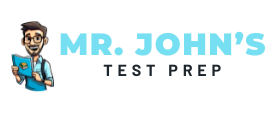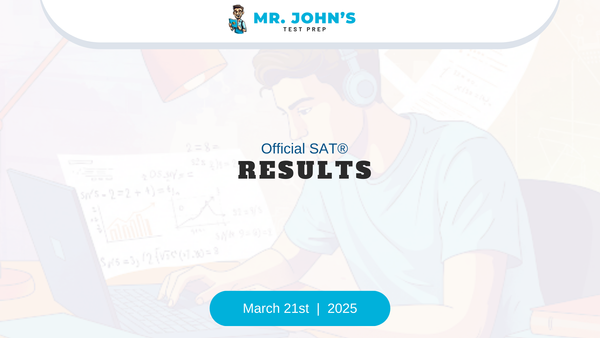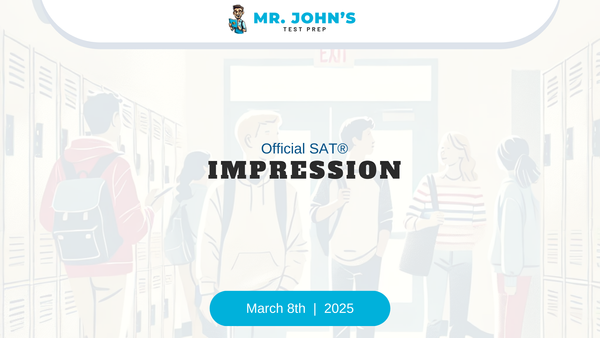March SAT 2025 Expectations

What to Expect for the March 2025 SAT
We don't expect much to change in the format of the SAT for March 2025, though it is possible. Last March proved to be a difficult test as the College Board introduced a variation in their format that played around with the amount of questions from each domain and skill. That could be a surprise this year.
Could the Format Change?
Much of the test should stay the same. The digital SAT still consists of two main sections: Reading and Writing and Math. You’ll have a mix of multiple-choice questions and write-in responses, with topics ranging from Algebra to Words in Context vocabulary-style questions. Additionally, there’s no guessing penalty, so answer every question!
With all that could be the same, there is a slight possibility that with the new year the College Board could introduce some sort of variation. Could it be a different type of grammar question than we are used to seeing? Could it be a reordering of the current linear design of the test? We don't know.
My guess is that they wouldn't introduce a new style of question, but continue playing with the order of questions and amount of each domain and skill. I saw this personally with the November and December tests, where module 2 in the Reading and Writing section featured fewer Words in Context questions giving way to more of the longer passage-style questions like Cross-Text Connections:

This is all within the scope of the College Board as they try to manipulate the test to create an "average" score.

What If They Add Longer Passage Questions?
The significance of adding any longer passage questions to a module and reducing the number of shorter vocabulary or grammar questions could serve to make the test seem harder. There are two reasons for this:
- Pacing: Common sense tells us that if we have to read 300 words or more of text to answer a question, it will take longer than a 75-100 word vocabulary or grammar question.
- Cognitive Fatigue: More reading comprehension, tougher pragmatics, and longer required focus can lead to cognitive fatigue. The College Board knows this and could weed out the faint at heart from reaching that perfect score by adding tougher texts to the test while keeping the amount of time required to finish the test the same.
What about Math?
Both pacing and cognitive fatigue could also be factors in the math section. In December, the second module contained several "write-in" answers at the end of module two. The departure from multiple choice means your ability to deductively reason through techniques like plug-and-chug and elimination is limited. You have to be precise with your answers.
Speed and Accuracy, and Normalizing the Load
What can you do to prepare for a potential March SAT with more of the longer reading passages? I'll tell you what I do with my students.
First, let's break students into two categories: those who are scoring near to 700 and above on either section and those who are closer to 600 or below.
- For my 700+ students, I typically recommend two approaches to studying: understanding my PROVE-IT ambiguity elimination method, and adding two or three tough questions to the mock tests while keeping the same time constraints. Eliminating ambiguity and normalizing the concentration and speed you need for test day are the only paths to a perfect score. I often add two Command of Evidence questions to the second Reading and Writing module for these students and require them to complete all 29 questions in under 33 minutes.
- For my 600-ish students, a perfect score is not always in sight, but it's worth striving for. I recommend these students perfect what knowledge is lacking in grammar, elimination techniques, vocabulary, transitions, and pacing strategies. Often, I find these students can get to the mid-700s by recognizing and fixing a few areas of weakness, plus focusing on time management.
Should You Take the SAT Linearly, Starting with Question 1 and Continuing Straight Through?
There are a few different approaches to tackling the SAT. Generally, for the Math section, I recommend moving linearly from start to finish. However, the Verbal section is not so cut and dry.

Having taken a myriad of real SATs, here's my two cents:
If you're the type of person who can get distracted with longer reading passages or who might suffer from cognitive fatigue, starting from the reading comprehension passages like Main Purpose, Central Ideas and Details, or Command of Evidence might be your best approach. These skills begin around questions 4-8, generally. This is the approach that works best for me, but I typically save it for the second module.
Here's why:
I breeze through the first module no matter where I start. It's easier, obviously. I then take the remaining time to relax my mind and eyes until the second module is ready to start.
Once the second module opens, I skip through the Words in Context section at the beginning in order to find the first passage question dealing with purpose and structure. This is where I start, and I move through all of the tough reading passages as efficiently and accurately as I can until I get to the end of the test. Then, I circle back to the vocabulary last.
Why do I do it this way? A couple of reasons.
- I'm playing to my strengths by saving vocabulary, grammar, transitions, and rhetorical synthesis for the end. I know I can breeze through these.
- It also gives me the fresh attention I need for the really tough reading comprehension passages. I save the easier questions for last when my brain is fried.
- Additionally, I find that if I get stuck on one of those tough passage questions, I can come back to it. When I do, I'm usually familiar with it.
Now, keep in mind, this requires a high-level understanding of the amount of time you can spend on each of these questions. If I'm going longer than two minutes, I have to move on and come back. But, generally speaking, this has been the best approach for me and many of my students.

Ultimately, I recommend experimenting. If you begin your preparation soon enough, you can take multiple mock tests and play around with your pacing strategies and starting points to see what works best for you.
Preparation Tips for the March SAT
- Start early: If you aren't already planning for the March, April, or May SAT dates, you're playing catch-up.
- Focus on high-impact strategies: Practice my PROVE-IT elimination method and review key grammar rules and math formulas.
- Take a mock test: It's the only way to know where you stand. Ideally, you should be taking a mock test every other weekend until the test date.

Final Thoughts
The March SAT is soon approaching. Preparation is the key to success. If you want help with your SAT prep, please reach out. I have limited space for spring and spots are filling up for 1-on-1 tutoring. Come join my other students and let's get you into that dream college!
Here's to a good curve!





